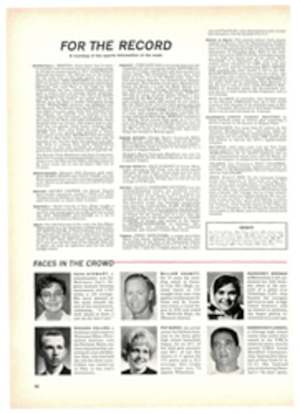
Like trees, boats should be wooden
I don't like the stuff. I don't like the way it looks. I don't like the way it feels. I don't even like the way it smells. The truth is," added the frustrated traditionalist, "fiber glass stinks!" Nevertheless, after years of unswerving fidelity to wooden hulls, that particular sailor has just bought himself a brand-new boat built of laminated fiber glass. "I suddenly realized," he said in lame apology, "that I enjoyed sailing more than I did sanding, caulking, priming, painting and pumping."
This attitude on the part of many other sailors, traditionalists and iconoclasts alike, has steadily increased both the output and consumption of fiber glass boats. At last year's National Motor Boat Show in New York 54% of the 475 boats on display were made of fiber glass. At the show that opened in New York this week the percentage of fiber glass over other materials had risen to 56%, and there seems little doubt that it will rise still higher at the 1966 show. More and more dinghies, outboards, cruisers, sports fishermen and ocean racers are blossoming out in fiber glass. And because of the ease with which it can reproduce a design, more and more new racing classes are born in fiber glass. Many old ones, among them Snipes, Lightnings and Wood Pussies—all traditionally dedicated to wood—are now admitting hulls of fiber glass into their ranks.
One notable exception to this trend is the Star class, which is still restricted to wood. And one notable holdout from the increasing army of fiber glass converts is the man who builds, and will continue to build—in wood—the best Star boats in the world. He is a 34-year-old artisan from San Diego named Carl Eichenlaub, and his revulsion and distaste for fiber glass is equaled only by that of the teredo worm. "I'll give up building boats before I ever use that stuff," he says.
Carl Eichenlaub's friends sometimes refer to him as Eichenslob—and not without reason. He wears a T shirt that Marlon Brando would hesitate to spit on, and his torn and stained blue jeans hang at least three degrees below the equator of his waistline. For years nobody has known the precise color of his close-cropped hair, because it invariably is camouflaged by several coats of marine paint and is generously powdered with sawdust.
The San Diego, Calif. boatyard where Eichenlaub practices his art is not much tidier than its owner. Power tools smudged with grime and pitted with rust lurk here and there under huge, dirty tarpaulins. Snakes of mysterious pipe wend their way aimlessly about. Scraps of cedar and mahogany strew the ground along with bits of rusty cast iron. An ancient Star boat with daylight seeping through its open seams occupies the only clear space in the yard, and near it rests the skeleton of a half-finished cruising boat that belongs to a do-it-yourself amateur who somehow persuaded the yard owner to rent him a corner to work in. "We're going to load it up with two of everything so we'll be ready when the rain starts," explains Carl Eichenlaub laconically.
The office from which Boatbuilder Eichenlaub supervises this garden of prosperity consists largely of rows and rows of dusty paint cans, a few pieces of spare boating gear and a broad front window with a sign that announces firmly at all times of the day or night: "Closed."
"If I let them think we were open," says Eichenlaub, "people might come in and bother me."
Despite his precaution and because Eichenlaub-built boats have, at one time or another, dominated the Snipe class, the Lightning class and especially the Star class, people bother him anyway. An Eichenlaub Star won every world championship from 1957 to 1960 and again in 1963. Of course it helped to have skippers like Lowell North, Joe Duplin and Bill Ficker sailing them, but a good skipper sailing a good boat will beat a good skipper sailing a bad one every time.
Because there are more good skippers than there are good boats, orders for Eichenlaub's Stars pour in from all over the world. Even the Russians have shown some interest. But if an order does not contain a cash deposit, say those close to Carl, he just throws it into the waste-basket.
In this age of production lines, quality control and cost inventories Eichenlaub is characteristically vague about his yard's output. "Good Lord, I haven't the faintest idea," he said when asked how many Stars he had built altogether. But loose records lying around the shop show that he built at least 17 Stars last year at $3,400 apiece, 11 Lightnings at $2,200 and six Snipes at $1,425. He is equally vague about how long it may take him and his lone assistant, George Froshower, to complete a job.
Although Eichenlaub once built a Snipe in three days in a round-the-clock push to get it done in time for a championship, his methods are not those of a time-study production line. Star boats as a class are becoming so refined that there is little one boatbuilder can do to distinguish his boats except to do what the other builder does and do it better—and lighter.
Lightness is all-important in a racing boat, but there is a dangerous hairline separating the kind of jerry-built lightness that will come unglued the first time wind and wave hit the boat and the lightness that will translate to speed. Eichenlaub toes that line like a ballet dancer. He cuts and sands, paints and fastens with infinite care and in just the right proportions, and he carefully weighs each plank to check it for moisture before putting it in place. An Eichenlaub Star, fully rigged and ready to sail, can weigh as little as 1,365 pounds. This is only half what a comparable fiber glass day sailer might weigh. "You'll hear about Stars weighing 1,350 pounds," Carl concedes, "but they weigh them without rig and sail."
"In many ways Carl is a genius," says Lowell North, a sailmaker who has three times sailed himself to a world championship in Eichenlaub Stars. "Although some sailors on the East Coast may not agree, we on the West Coast know that he is the best."
There is some talk now among Star sailors on both coasts of admitting fiber glass hulls into their sacrosanct fleets. But the talk does not bother Carl Eichenlaub. He is confident that, fashioned by the right hands, a wooden boat will always triumph over one made of this alien material, and his confidence is not rooted in mere prejudice. After a yearlong study, he is convinced that the resins which hold the layers of fiber glass together to make a molded hull go on curing for months after the hull has been taken from the mold. This means, in Eichenlaub's view, that the boat will go on changing shape for as long as a year. Since one thirty-second of an inch in the wrong place would be an unthinkable horror in an Eichenlaub Star, these twisted monsters (in Eichenlaub's view) offer him no threat. "If a wooden boat changes shape," he says, "it's fairly easy to correct. With fiber glass, you're in a mess."
If what he says is true—the glass people strongly deny it—this might prove a reasonable argument against fiber glass. But Carl Eichenlaub has what he thinks is an even stronger one. "Boats," he says with the finality of a busy man who doesn't like a lot of foolish palaver, "are supposed to be made of wood."
PHOTO

